
National Institutional Ranking Framework (NIRF)
Syllabus: GS 2/Education
In News
- The National Institutional Ranking Framework (NIRF) announced the India Rankings 2023 of higher education institutions.
- For the 2023 rankings, 5,543 unique institutions applied for ranking.
National Institutional Ranking Framework (NIRF)
- It has been accepted by the MoE and launched by the Honourable Minister for Education on 29th September 2015.
- This framework outlines a methodology to rank institutions across the country.

- This is the eighth consecutive edition of India Rankings of HEIs in India.
Distinct additions of the 2023 edition
- Introduction of a new subject namely Agriculture & Allied Sectors
- Integration of the “Innovation” ranking previously executed by the Atal Ranking of Institutions on Innovation Achievements (ARIIA) into the India Rankings with an aim to reduce the burden on institutions of providing similar data to two different agencies.
- Expansion of scope of “Architecture” to “Architecture and Planning” to include institutions imparting courses in Urban and Town Planning.
Key Highlights of India Rankings 2023
- Indian Institute of Technology Madras retains its 1st position in Overall Category for a fifth consecutive year, i.e. 2019 to 2023, and in Engineering for an eighth consecutive year, i.e. from 2016 to 2023.
- Indian Institute of Science, Bengaluru tops the Universities Category for the eighth consecutive year, i.e. from 2016 to 2023.
- It stood first in the Research Institutions Category for the third consecutive year, i.e. from 2021 to 2023.
- IIM Ahmedabad tops in Management subjects retaining its first position for the fourth consecutive year, i.e. from 2020 to 2023. It was ranked among the top two in Management subject of the India Rankings from 2016 to 2019.
- All India Institute of Medical Sciences (AIIMS), New Delhi occupies the top slot in Medical for the sixth consecutive year, i.e. from 2018 to 2023.
- Moreover, AIIMS is ranked at 6th position in the Overall category thereby improving from its 9th position in 2022.
- National Institute of Pharmaceutical Education and Research, Hyderabad tops the ranking in Pharmacy for the first time pushing Jamia Hamdard to the second slot.
- Miranda House retains the 1st position amongst Colleges for the seventh consecutive year, i.e. from 2017 to 2023.
- IIT Roorkee stands at 1st position in Architecture subject for the third consecutive year, i.e. from 2021 to 2023.
- National Law School of India University, Bengaluru retains its first position in Law for the sixth consecutive year, i.e. from 2018 to 2023
- Indian Agricultural Research Institute, New Delhi takes the top slot in Agriculture and Allied Sectors.
- Indian Institute of Technology Kanpur tops in the Innovation category.
Importance of rankings
- Ranking and accreditation are vital for evaluating the quality of educational programs offered by higher education institutions in colleges and universities.
- India Rankings serve as a valuable tool for students in identifying universities based on their relative standing in various categories and subject domains among higher educational institutions (HEIs) in the country.
- It has also helped universities in identifying areas for improvement in teaching, research, resources, and infrastructure.
Source: TH
India and Suriname
Syllabus: GS 2/International Relations
In News
- President Droupadi Murmu is on a 3-day state visit to Suriname.
- She has been decorated with the highest civilian honour of Suriname – The Grand Order of the Chain of Yellow Star.
- She is the first Indian to receive this award.
Key Highlights of the Visit
- Both the countries discussed ways to deepen India-Suriname relations and held wide-ranging discussions on multiple areas including defence, agriculture, IT, and capacity building,”
- 3 MoUs were signed between the two countries.
- Two MoUs were signed in the field of Health and one in the field of Agriculture.
- The Government of India also announced the supply of essential medicines worth 5.1 Cr rupees to Suriname to aid the Caribbean country’s flood relief efforts.
- India has extended the Overseas Citizenship of India (OCI) facility to the 5th & 6th generation of Persons of Indian origin in Suriname.
- This was a long pending demand of the Indian diaspora there.
India-Suriname Relations
- Historical Linkages: India shares close, warm, and friendly relations with Suriname with historical linkages.
- Soon after Suriname’s Independence on November 25, 1975, India established diplomatic relations in 1976.
- Cooperation at the International level: Suriname and India actively cooperate on various multilateral fora.
- Suriname has been supporting India’s candidature on various multilateral platforms including elections of different bodies under the UN.
- Economic: Trade and economic links between India and Suriname are modest.
- Indian export to Suriname consists of boilers, machinery, iron & steel, electrical machinery & equipment, sound recorders, pharmaceutical products, textiles, vehicles, coffee, tea and spices, rubber, paper, tobacco, organic chemicals, furniture, carpets, ceramic products, footwear and printed books.
- Indian import consists of wood, aluminum and electrical machinery.
- Indian diaspora: The first ship carrying 452 Indian labourers arrived in Suriname’s capital Paramaribo on June 5, 1873. Most of the labourers hailed from eastern Uttar Pradesh and Bihar.
- India-Suriname relations acquire special significance on account of the Indian diaspora, which is over 27 percent of the Suriname population.
- Culture And Education: Indian Cultural Centre in Suriname was opened in 1978 and is quite active in promoting the Hindi language, Kathak, Yoga, and classical music
- India provided a yearly grant worth US 29500/- for the promotion of Hindi in Suriname through Suriname Hindi Parishad until 2019.
Potential and Importance
- Deep historical and cultural ties provide the foundation for the India-Suriname multifaceted and modern partnership.
- The agreements signed during the recent visit would help boost trade and economic ties.
- The signing of MoUs, in the sector of Health, will open the Suriname market for Indian pharma industries.
Future Outlook
- Bilateral trade between the two countries is well below potential.
- There is scope for further collaboration in sectors like pharmaceuticals, Ayurveda, agriculture, and defence.
- Therefore, there is a need to work together to expand bilateral trade for mutual benefit.
- The recent visit will add fresh momentum too and further strengthen India-Suriname bilateral ties.
Source: News on air
Pulses Production in India
Syllabus: GS3/ Indian Economy & related issues, Agriculture
In News
- There are two agricultural commodities in which India is significantly import-dependent: Edible oil and pulses.
About
- India’s import of pulses dropped by 60 per cent between 2017-18 and 2022-23 as their production increased 9 per cent.
- The Union government has prepared a plan to focus on increasing the production of pulses to make the country self-sufficient over the next three years.
Imports of Vegetable Oil
- Out of the 24-25 million tonnes (mt) cooking oil that the country consumes annually, only 9-10 mt is from domestically produced grain. The balance 14-15 mt is imported.

Relatively Atmanirbhar in pulses
- In quantity terms, India’s imports of pulses more than doubled from 3.18 mt in 2013-14 to 6.61 mt in 2016-17. From those peaks, they have come down to 2.70 mt in 2021-22 and 2.52 mt in 2022-23.
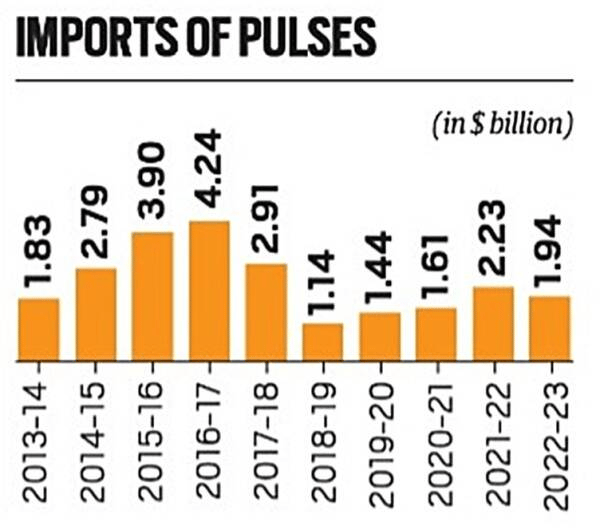
- According to the Agriculture Ministry, India’s pulses output has increased from 19.26 mt in 2013-14 to 27.50 mt in 2022-23.
- The reduction in pulses imports have come essentially on the back of higher domestic production.
- It can be seen that imports of two items have recorded dramatic drops: Yellow/white peas (matar) and chickpea (chana).
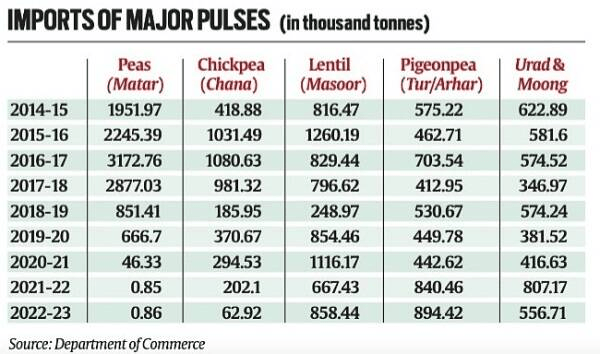
Image: Breakup of India’s imports of major pulses
- The boost to chana production came from two key government measures like:
- Incentivizing Indian farmers to expand area under the pulses crop grown during the rabi (winter-spring) season.
- Levy of a 60% import duty on chana since March 2018. In yellow/white peas, there is a 50% duty plus a minimum price of Rs 200/kg below which imports are not permitted.
- Government’s procurement at minimum support prices (MSP).
Indian Pulses Sector
- India is the largest producer (25% of global production), consumer (27% of world consumption) and importer (14%) of pulses in the world.
- Pulses account for around 20 percent of the area under food grains and contribute around 7-10 per cent of the total foodgrains production in the country.
- Though pulses are grown in both Kharif and Rabi seasons, Rabi pulses contribute more than 60 per cent of the total production.
- Major pulses are grown chickpeas (gram), pigeon pea (tur or arhar), moong beans, urad (black matpe), masur (lentil), peas and various kinds of beans.
- Gram is the most dominant pulse having a share of around 40 per cent in the total production followed by Tur/Arhar at 15 to 20 per cent.
- Madhya Pradesh, Maharashtra, Rajasthan, Uttar Pradesh and Karnataka are the top five pulses producing States.
- The United Nations declared 2016 as “International Year of Pulses” (IYP) to heighten public awareness of the nutritional benefits of pulses as part of sustainable food production aimed at food security and nutrition.
Climatic Conditions Required
- Pulse crops are cultivated in Kharif, Rabi and Zaid seasons of the Agricultural year.
- Rabi crops require mild cold climate during sowing period, during vegetative to pod development cold climate and during maturity / harvesting warm climate. Similarly, Kharif pulse crops require a warm climate throughout their life from sowing to harvesting. Summer pulses are habitants of warm climates.
- Kharif: Arhar (Tur), Urd (Blackgram), Moong (Greengram), Lobia (Cowpea), Kulthi (Horse Gram) and Moth;
- Rabi: Gram, Lentil, Pea, Lathyrus and Rajmash;
- Summer: Greengram, Blackgram and Cowpea
Benefits of pulses
- Pulses offer many benefits like:
- They are nitrogen fixers (Conserve soil nutrients)
- Cost advantages – it takes considerably lower amounts of resources to grow pulses
- Great for intercropping and crop rotation practises
- Climate resilience
- Longer shelf life
- Need very little processing
- Contribute to Global Food Security
Challenges to the Pulse Production
- Poor and inadequate storage facilities
- Volatility in the prices due to rainfed dependency of the crops
- Decrease in the cultivation area. Farmers opting Higher Yielding Crops with higher MSP.
- Inconsistencies in Minimum Support Price (MSP) like the Agricultural Costs and Prices Commission who fixes MSP is by status a department whose recommendations are only advisory.
- Representation of farmers is minimal.
- The so-called 50 per cent profit to the farmer is not per the government’s intended formula, and so it is relatively low. The farmers do not even get the declared MSP.
- The pulses are imported at prices lower than the domestic ones.
- Vulnerability to pests is also a major hindrance in the production of pulses.
- Farmers lack crop Insurance and credit facilities.
|
Minimum Support Price (MSP)
|
Reforms Needed
- Revision of MSP Formula: First of all, the MSP formula should be revised and the purchase of each crop in the entire country should be ensured at that declared price.
- Reforming Commission: The Agricultural Costs and Prices Commission should be given constitutional status, so that its recommendations are binding.
- Maximum retail price for consumers: A maximum retail price for consumers should be fixed by adding a reasonable profit of 50-60 per cent over MSP to the farmer.
- Abolishment of Restrictions: All restrictions on transport, storage, trade, processing and export of all agricultural products should be abolished. In case of low domestic production, imports and taxes should be decided after the harvest.
Subramanian committee recommendations
- In 2015, the Union government set up a committee headed by the then chief economic adviser Arvind Subramanian to review the policy interventions required to incentivise the cultivation of pulses.
- Recommendations:
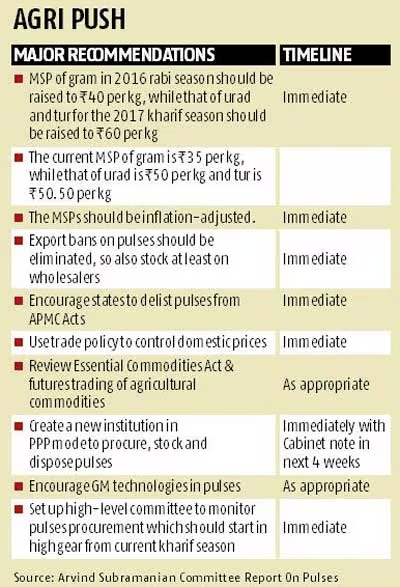
Government measures
- NFSM (National Food Security Mission): Launched by the Government of India during 2007-08 at the beginning of the 11th five-year plan.
- The two-pronged strategy was followed by NFSM to achieve this.
- To expand the area under cultivation of pulses, and;
- To enhance productivity by bridging the gap between the actual and potential yield.
- The two-pronged strategy was followed by NFSM to achieve this.
- RKVY (Rashtriya Krishi Vikas Yojana) programme: It is a continuing scheme under implementation from the 11th Five Year Plan period of National Development Council (NDC). The scheme will incentivize States in enhancing more allocation to Agriculture and Allied Sectors.
- PM-POSHAN: The Indian government has urged states to procure pulses (for Mid-day meals) under the PM-POSHAN (Prime Minister’s Overarching Scheme for Holistic Nutrition) program from NAFED (National Agricultural Cooperative Marketing Federation of India Ltd.).
- World Pulses Day: February 10 is a designated global event to recognize and emphasize the importance of pulses and legumes as a global food. The UN General Assembly adopted 2016 as the International Year of Pulses (IYP).
Conclusion
- Considering further limited expansion of cultivated area, the future high demand of pulses must come from increase in yield. Therefore adaptive research and technology assessment, refinement and transfer capabilities of the country need to be strengthened so that the existing technology transfer gaps are bridged.
- For this, an appropriate network of extension service needs to be created for flowing information between farmers, extension workers, and scientists to promote generation, adoption, and evaluation of location-specific technologies.
Source: IE
Antardrishti (Financial Inclusion)
Syllabus: GS3/ Indian Economy & related issues
News
- In June 2023, the Reserve Bank of India (RBI) Governor launched a Financial Inclusion Dashboard, named Antardrishti.
Antardrishti
- The dashboard will provide the required insight to assess and monitor the progress of financial inclusion by capturing relevant parameters.
- The dashboard, presently intended for internal use in the RBI, will further facilitate greater financial inclusion through a multi-stakeholder approach.
Financial inclusion
- Meaning: Financial inclusion is the process of ensuring access to financial products and services needed by vulnerable groups at an affordable cost in a transparent manner by institutional players.
- Background: The concept of financial inclusion was first introduced in India officially in 2005 by the Reserve Bank of India.
- The objectives of financial inclusion are to provide the following:
- A basic no-frills banking account for making and receiving payments
- Saving products (including investment and pension)
- Simple credit products and overdrafts linked with no-frills accounts
- Remittance, or money transfer facilities
- Micro insurance (life) and non-micro insurance (life and non-life)
- Micro pension and
- Financial Literacy.
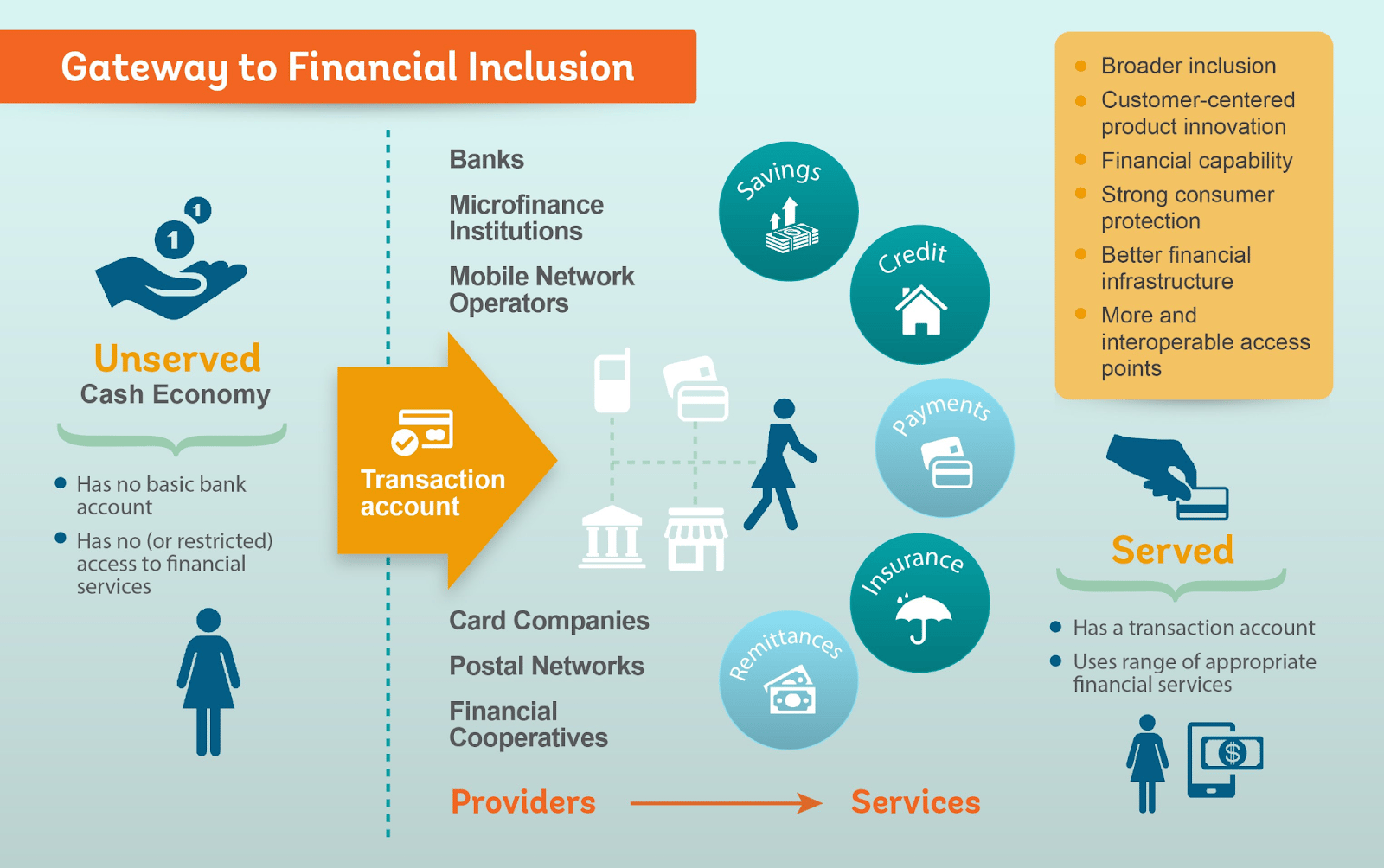
Significance of Financial Inclusion
- Financial inclusion strengthens the availability of economic resources and builds the concept of savings among the poor.
- Financial inclusion is a major step towards inclusive growth. It helps in the overall economic development of the underprivileged population.
- In India, effective financial inclusion is needed for the uplift of the poor and disadvantaged people by providing them with the modified financial products and services.
Challenges in Achieving Financial Inclusion
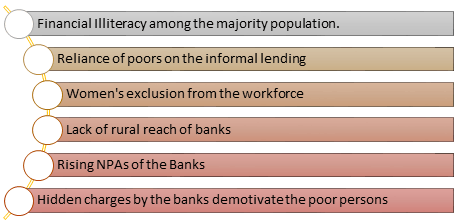
Pradhan Mantri Jan Dhan Yojana (PMJDY)
- It is the National Mission on Financial Inclusion to ensure access to financial services, namely, basic savings & deposit accounts, remittance, credit, insurance, pension in an affordable manner.
- It was launched by PM Modi in August 2014.
- Benefits under PMJDY
- One basic savings bank account is opened for unbanked people.
- There is no requirement to maintain any minimum balance in PMJDY accounts.
- Interest is earned on the deposit in PMJDY accounts.
- Rupay Debit card is provided to the PMJDY account holder.
- Accident Insurance Cover of Rs.1 lakh (enhanced to Rs. 2 lakh to new PMJDY accounts opened after 28.8.2018) is available with RuPay card issued to the PMJDY account holders.
- An overdraft (OD) facility up to Rs. 10,000 to eligible account holders is available.
- PMJDY accounts are eligible for Direct Benefit Transfer (DBT), Pradhan Mantri Jeevan Jyoti Bima Yojana (PMJJBY), Pradhan Mantri Suraksha Bima Yojana (PMSBY), Atal Pension Yojana (APY), Micro Units Development & Refinance Agency Bank (MUDRA) scheme.
Financial Inclusion (FI) Index
- RBI constructed the Financial Inclusion (FI) Index in 2021 to measure the extent of financial inclusion.
- It is based on three dimensions (weights indicated in brackets): Access (35 per cent), Usage (45 per cent), and Quality (20 per cent).
Other financial inclusion schemes in India
- Jeevan Suraksha Bandhan Yojana,
- Pradhan Mantri Mudra Yojana,
- Pradhan Mantri Suraksha Bima Yojana (PMSBY),
- Atal Pension Yojana (APY),
- Varishtha Pension Bima Yojana (VPBY),
- Credit Enhancement Guarantee Scheme (CEGS) for scheduled castes, and
- Sukanya Samriddhi Yojana.
Source: BS
MISHTI (Mangrove Initiative for Shoreline Habitats and Tangible Incomes)
Syllabus: GS3/ Environment
In News
- On the occasion of World Environment Day (June 5, 2023), PM Modi launched the MISHTI (Mangrove Initiative for Shoreline Habitats and Tangible Incomes). The scheme was first announced by the Union finance minister in the 2023-24 Union budget.
MISHTI (mangrove initiative for shoreline habitats and tangible incomes)
- Targets: Initially the mangrove cover will be restored in nine states across the country. Overall, the scheme envisages the development of mangroves covering nearly 540 sq km, spreading across 11 states and two union territories over five years, starting from FY2023-24.
- Expected benefits: This scheme will help in mitigating the threat to lives and livelihoods in coastal areas from rising sea levels and disasters like cyclones.
- Strategy: It involves the sharing of best practices on plantation techniques, management practices, conservation measures and resource mobilization through the public-private partnership route.
- Funding: The Centre covers 80% of the project cost, while state governments contribute the remaining 20%.
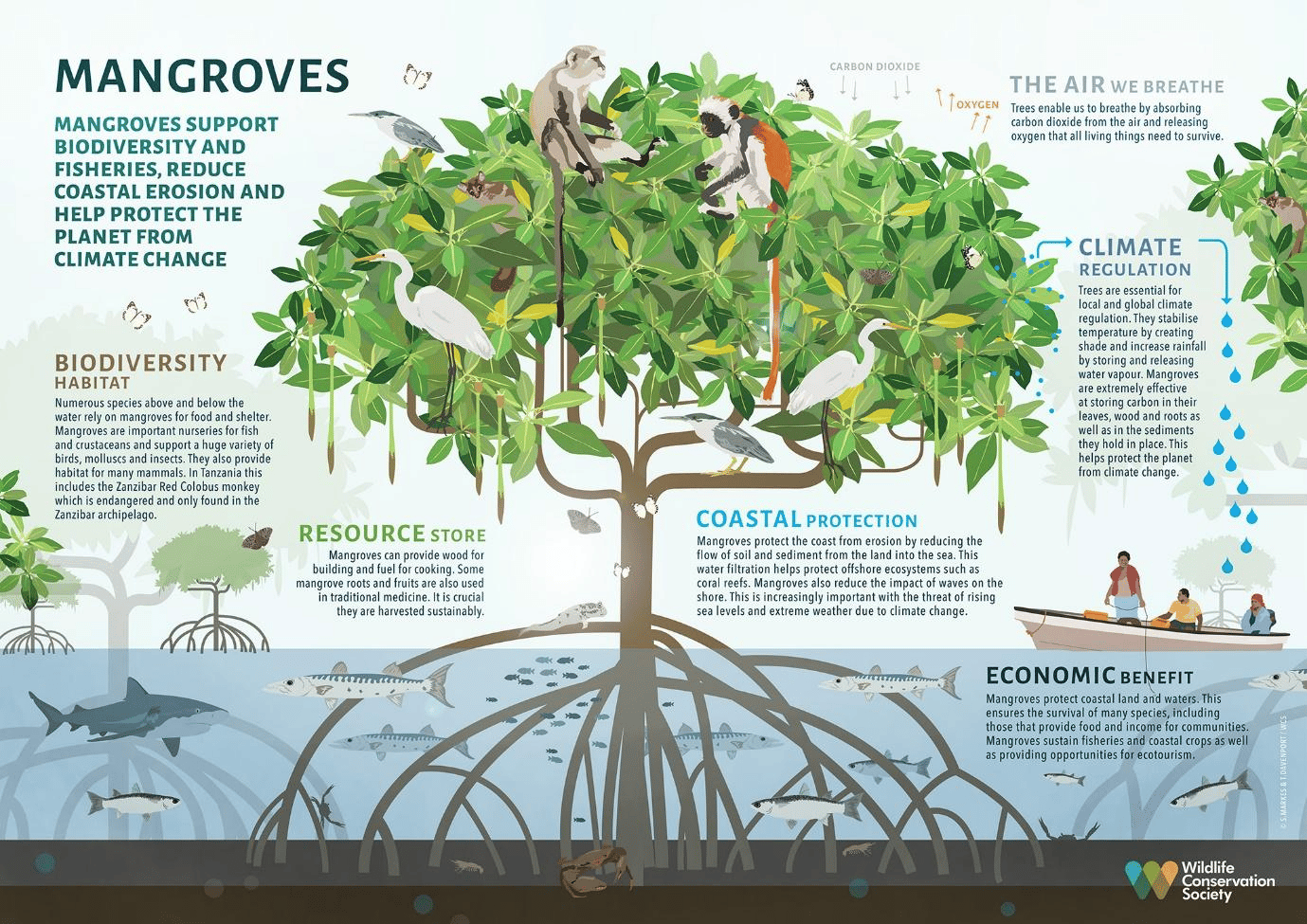
Mangrove Forests
- A mangrove is a shrub or a small tree that lives in intertidal water in coastal areas and has roots in salty sediments, often underwater. They also grow in swamps.
- Mangroves are salt tolerant plant communities found in tropical and sub-tropical intertidal regions of the world. Such areas are characterized by high rainfall (between 1,000 to 3,000 mm) and temperature (ranging between 26°C-35°C).
- Mangrove forests can survive extreme weather conditions and require low oxygen levels to survive. The mangroves cannot survive freezing temperatures and thus are found mainly in tropical and subtropical latitudes.
Significance of Mangroves
- Carbon Sink: Mangrove forests can store ten times more carbon per hectare than terrestrial forests. Also, they can store carbon up to 400 per cent faster than land-based tropical rainforests.
- Blue Carbon: Once the plants die, they take the stored carbon into the soil. This is called “Blue Carbon”.
- Disaster management: Moreover, Mangrove forests act as natural barriers against rising tides and storms. Each year, they prevent property damages of over $65 billion.
- Biodiversity: They provide breeding grounds for marine biodiversity and 80% of global fish populations depend on healthy mangrove ecosystems.
- Employment: They also support a rich food web, with molluscs and algae-filled substrate acting as a breeding ground for small fish, mud crabs and shrimps, thus providing a livelihood to local artisanal fishers.
|
Do you know?
|
Threats
- Between 2010 and 2020, around 600 sq. km of mangroves were lost of which more than 62% was due to direct human impacts, the Global Mangrove Alliance said in its 2022 report.
- Infrastructure projects — industrial expansion and building of roads and railways, and natural processes — shifting coastlines, coastal erosion and storms, have resulted in a significant decrease in mangrove habitats.
Mangrove Cover: Worldwide
- As per Global Forest Resource Assessment, 2020 (FRA 2020), world over, 113 countries have Mangrove forests covering an estimated 14.79 million hectares. The largest Mangrove area is reported in Asia (5.55 million hectares), followed by Africa (3.24 million hectares)
- More than 40 percent of the total area of Mangroves was reported to be in just four countries: Indonesia (19 percent of the total), Brazil (9 percent), Nigeria (7 percent) and Mexico (6 percent).
Mangrove Cover: India
- According to the Forest Survey report 2021, mangroves cover in the country is 4,992 square km, which is 0.15 percent of the country’s total geographical area. Since 2019, the cover has risen by only 17 sq. km.
- India accounts for about 3% of South Asia’s mangroves.
- West Bengal has 42.45% of India’s mangrove cover (mainly because of Sundarbans), followed by Gujarat (23.66%) and Andaman and Nicobar Islands (12.39%). Other states that have mangrove cover are Maharashtra, Odisha, Andhra Pradesh, Tamil Nadu, Goa and Kerala.
- Important species of Mangrove ecosystems in India include Avicennia officinalis, Rhizophora mucronata, Sonneratia alba, Avicennia alba, Bruquiera cylindrica, Heritiera littoralis, Phoenix paludosa, Morinda citrifolia & Ceriops tagal.
Sundarbans
- Sunderban, located in the northern Bay of Bengal is the world’s largest single patch of Mangrove Forests.
- Spread over approximately 10,000 sq km, in Bangladesh and India, Sundarban is the first Mangrove forest in the world, which was brought under scientific management, as early as in 1892.
- Status: Four protected areas in the Sundarbans are enlisted as UNESCO World Heritage Sites, viz. Sundarbans National Park (India), Sundarbans West (Bangladesh), Sundarbans South (Bangladesh) and Sundarbans East (Bangladesh).
|
Mangrove Alliance for Climate (MAC)
|
Source: LM
Rare Higgs Boson Decay
Syllabus: GS3/Science & Technology
In News
- Recently scientists have reported that they had detected a Higgs boson decaying into a Z boson particle and a photon.
What is Higgs Boson?
- The Higgs boson is the fundamental particle associated with the Higgs field, a field that gives mass to other fundamental particles such as electrons and quarks.
- Quarks and gluons are the building blocks of protons and neutrons, which in turn are the building blocks of atomic nuclei. Scientists’ current understanding is that quarks and gluons are indivisible—they cannot be broken down into smaller components.
- The stronger a particle’s interaction with the Higgs boson, the more mass it has. This is why electrons have a certain mass, protons have more of it, and neutrons have just a little bit more than protons, and so on.
- The Higgs boson was proposed in 1964 by Peter Higgs, François Englert, and four other theorists to explain why certain particles have mass.
- The particle was finally discovered in 2012, by researchers at the Large Hadron Collider (LHC) — the most powerful particle accelerator in the world — located at the European particle physics laboratory CERN, Switzerland.
- The LHC confirmed the existence of the Higgs field and the mechanism that gives rise to mass and thus completed the standard model of particle physics  —  the best description we have of the subatomic world.
- This discovery led to the 2013 Nobel Prize in Physics being awarded to Higgs and Englert.
- Application: Since all the matter in the universe is made of these particles, working out how strongly each type couples to Higgs bosons, together with understanding the properties of Higgs bosons themselves, can tell us a lot about the universe itself.
- It is sometimes referred to as the “God Particle” as well.
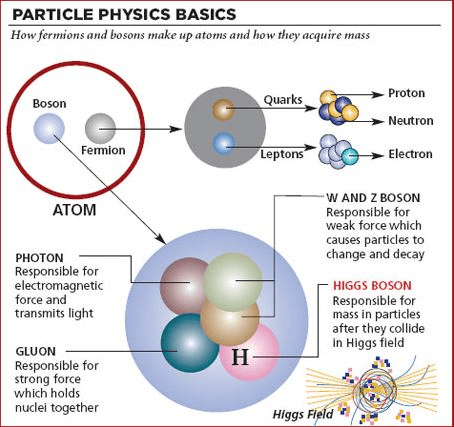
Standard Model:
- The Standard Model predicts that the Higgs boson will take this path 0.1% of the time if its mass is 125 billion eV/c2 (a unit of mass used for subatomic particles).
- The Standard Model has made many accurate predictions but it can’t explain what dark matter is or, in fact, why the Higgs boson is so heavy.
- Testing its predictions as precisely as possible is a way for physicists to find whether there are any cracks in the Model – cracks through which they can validate new theories of physics.
- For example, some theories predict a higher rate of decay through this pathway; if the LHC and its detectors find experimental proof of that, the new theories could open a new realm of science.
Rare Decay Process
- Scientists have detected a Higgs boson decaying into a Z boson particle and a photon. This is a very rare decay process that tells us important things about the Higgs boson as well as about our universe.
- The Higgs boson is a heavy particle and that is why it is an unstable particle that decays into lighter particles. We can’t always say which combination of particles it will decay into. However, the theory that describes the properties of fundamental particles has clearly predicted the probability that it will take a given path.
- The Standard Model says that a Higgs boson will decay to a Z boson and a photon 0.1% of the time. This means the LHC needed to have created at least 1,000 Higgs bosons to have been able to spot one of them decaying to a Z boson and a photon. As it happens, the Z boson is also unstable.
- This significance is even now not high enough for the teams to claim a Higgs boson decayed to a Z boson and a photon with 100% certainty, reflecting the rarity of the decay pathway.
Source: TH
Goomty
Syllabus : Miscellaneous
In News
- The Indian Railways has decided to secure the goomties days after the devastating three-way train accident in Odisha
About Goomty
- A goomty is a small cabin at level crossings or near stations where railway equipment is kept.
- In other words, it houses signaling equipment on railway station premises with a double-lock arrangement.
- Recent Directions: Launch a month-long safety drive to ensure that the goomties located within the railway station limits are provided with double locks.
Source: TH
‘100 Days 100 Pays’ Campaign (Unclaimed Deposits)
Syllabus: GS3/ Economy
In News
- The Reserve Bank of India (RBI) launched the ‘100 Days 100 Pays’ Campaign for Return of Unclaimed Deposits.
About
- Balances in savings / current accounts which are not operated for 10 years, or term deposits not claimed within 10 years from date of maturity are classified as “Unclaimed Deposits”.
- These amounts are transferred by banks to “Depositor Education and Awareness” (DEA) Fund maintained by the Reserve Bank of India.
- In May 2023, the RBI announced a ‘100 Days 100 Pays’ campaign for banks to trace and settle the top 100 unclaimed deposits of every bank in every district of the country within 100 days.
- This campaign will aim to reduce the quantum of unclaimed deposits in the banking system and return such deposits to their rightful owners/ claimants.
Source: PIB
India’s First International Cruise Vessel
Syllabus: GS3/ Economy
News
- The Union Minister of Ports, Shipping & Waterways flagged off MV Empress, India’s first international cruise vessel – from Chennai to Sri Lanka in Chennai.
About
- The cruise service is the result of an MoU signed during the first Incredible India International Cruise Conference in 2022 between Chennai Port and M/S Waterways Leisure Tourism Pvt Ltd to start domestic and international cruise service.
- The cruise service will sail to three Sri Lankan ports; viz. Hambantota, Trincomalee, and Kankesanturei.
To read about Ganga Vilas ‘World’s Longest River Cruise’, refer the following link
https://www.nextias.com/current-affairs/13-01-2023/ganga-vilas-worlds-longest-river-cruise
Source: PIB
Amrit Dharohar Yojana
Syllabus: GS3/ Environment
News
- On the occasion of World Environment Day (June 5, 2023), PM Modi launched the Amrit Dharohar Yojana. The scheme was first announced by the Union finance minister in the 2023-24 Union budget.
About
- The scheme will ensure conservation of the existing Ramsar sites with the help of local communities over the next three years.
- These Ramsar sites will become centres of eco-tourism and a source of green jobs for thousands of people.
- India currently has 75 Ramsar sites that are wetlands of international importance and designated under the Ramsar Convention on Wetlands.

To read about Ramsar Wetland Sites
https://www.nextias.com/current-affairs/17-08-2022/ramsar-wetlands-sites
Source: LM